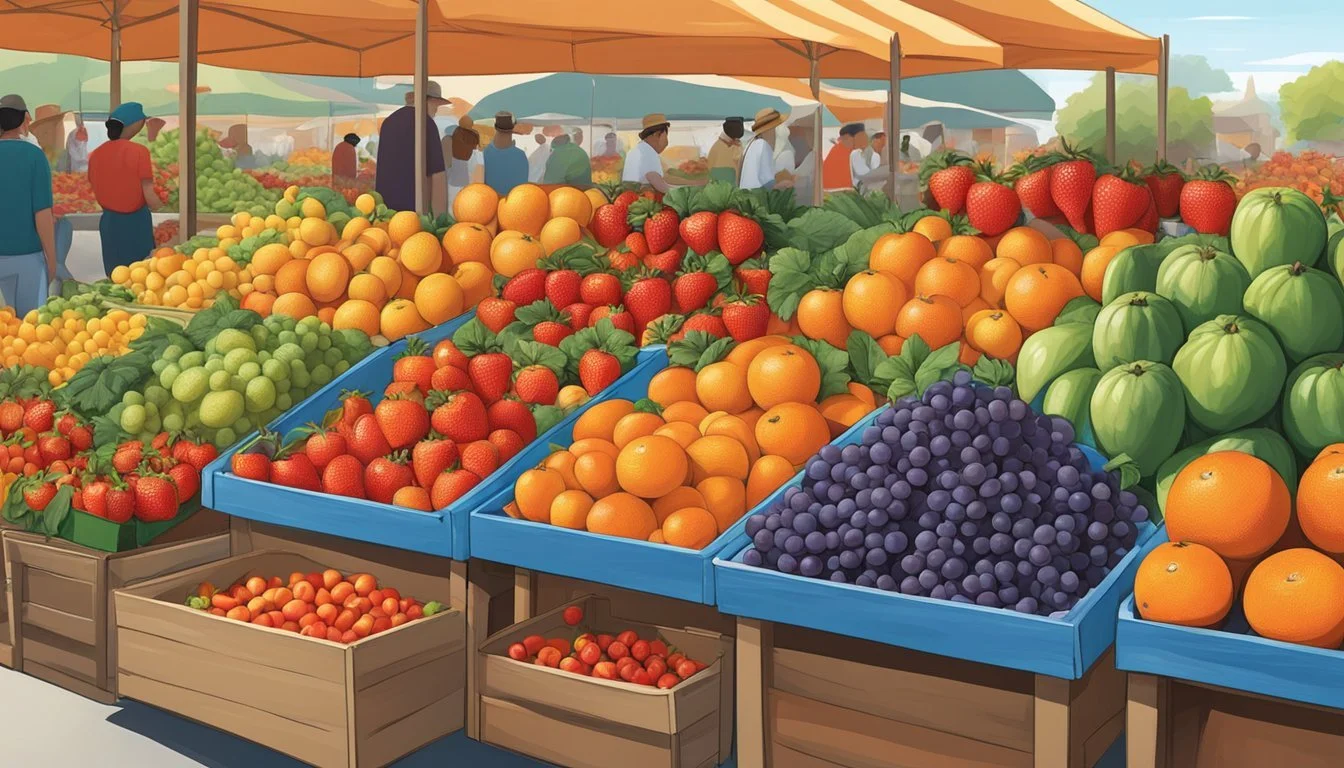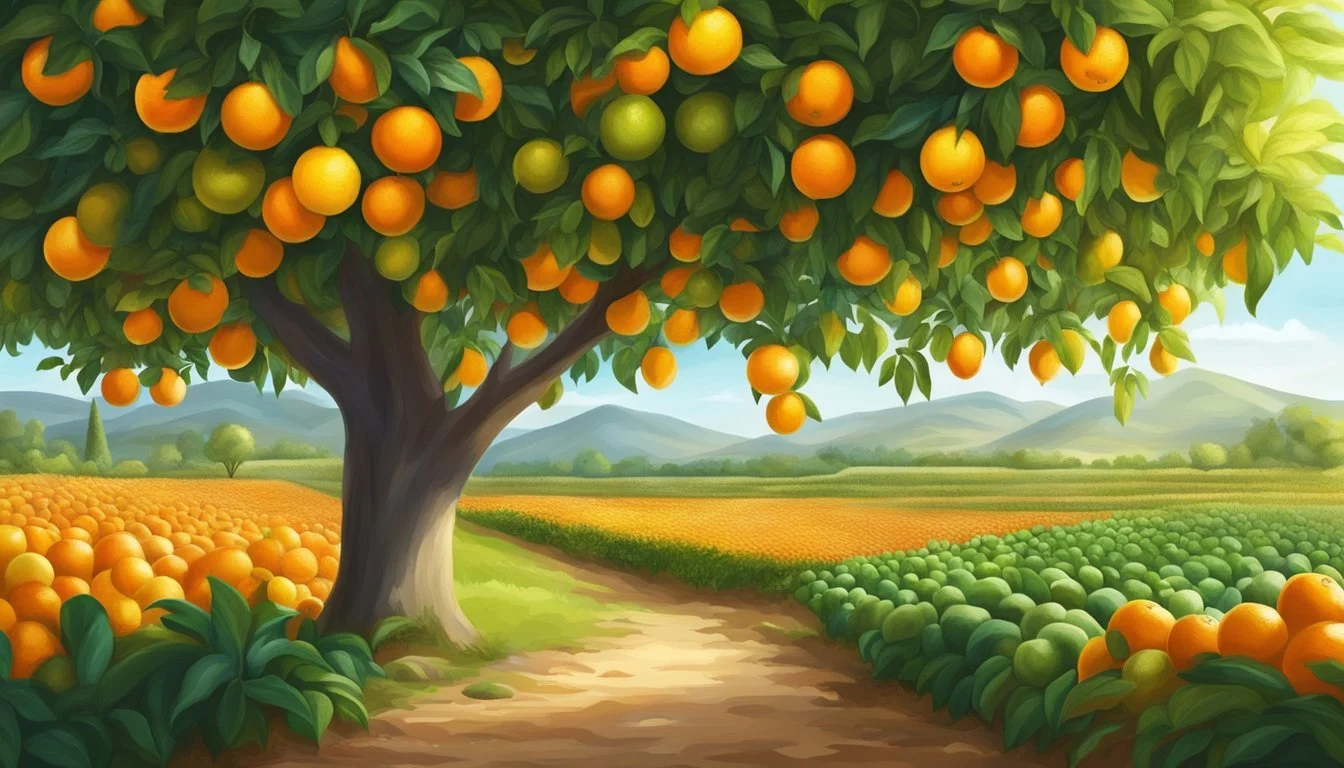Florida Seasonal Fruit & Vegetables in November
Your Guide to Fresh Produce
This Article is Part of our Florida Seasonal Fruit & Veg Calendar
Florida's climate offers a unique agricultural advantage, allowing a vast array of fruits and vegetables to thrive throughout various seasons. In November, the region's seasonal offerings are at their peak, benefiting from the state's mild fall temperatures. This period is ideal for a bounty of produce, each ripening under the Floridian sun to provide optimal flavor and nutrition. The diverse ecosystem ranging from the panhandle down to the tropical south enables farmers to grow a rich variety of produce.
As November marks the beginning of Florida's cooler season, a plethora of winter crops become available. The state's agriculture is not limited by the single harvest cycles often seen in colder climates. Instead, Florida's growing season extends through winter months, providing fresh, locally grown fruits and vegetables. Shoppers and chefs alike eagerly anticipate the arrival of November's harvest, which includes staples such as oranges, grapefruits, and tangerines—citrus fruits that Florida is renowned for.
In addition to citrus, the state yields an impressive selection of vegetables during November. Root vegetables such as radishes, beets, and turnips, along with cruciferous varieties like cauliflower (how long does cauliflower last?) and broccoli (how long does broccoli last?), are harvested. Leafy greens, including varieties of lettuce and spinach, also reach their peak during this time. The continuous cycle of planting and harvesting throughout Florida's regions creates a constant supply of fresh produce, supporting both local markets and the farm-to-table movement that cherishes the connection between the land and the dinner plate.
Understanding Florida's Growing Seasons
Florida's climate is notably conducive to year-round growing, thanks to its humid subtropical and tropical weather. The state observes multiple growing seasons, primarily based on the mild winter and long, hot summer periods.
Fall: Starting in September, fall is identified by a decrease in humidity and cooler temperatures, which lasts until November. This season is ideal for planting a variety of vegetables due to the reduced risk of heat stress on plants.
Winter: Florida's winters are mild, with rare instances of frost. From December through February, the temperatures are cool enough to support crops that might struggle in the summer heat.
Spring: March heralds the start of spring, a time when the warmth begins to return. This season extends until May and is characterized by a significant increase in planting activity.
Summer: June through August marks the summer season. Intense heat and high humidity can be challenging for some crops; thus, farmers and gardeners often choose heat-tolerant plants during this period.
Each region within Florida—North, Central, and South—has its own specific planting guides due to variations in weather patterns:
North Florida experiences cooler temperatures and a more defined winter, affecting planting schedules.
Central Florida has a temperate climate which can accommodate an array of crops, nearly year-round.
South Florida benefits from warm temperatures throughout the year, typically observing a single, extended growing period rather than distinct seasons.
Here's a simplified overview for clarity:
Season N. Florida C. Florida S. Florida Fall Sep - Nov Sep - Nov Sep - Nov Winter Dec - Feb Dec - Feb Mild Spring Mar - May Mar - May Early onset Summer Jun - Aug Jun - Aug Extended
Understanding these regional differences is crucial for planting schedules and crop management, as it influences what and when farmers can grow and harvest throughout the state.
Seasonal Fruits Available in November
Florida's November harvest offers a rich variety of fruits, from citrus rich in Vitamin C to succulent tropical varieties. The availability of antioxidants-loaded produce peaks, providing consumers with an abundance of healthy choices.
Citrus Fruits
In November, citrus fruits are abundant in Florida, presenting a collection of flavors and health benefits. Grapefruits and oranges lead the selection, along with other citrus varieties like tangerines, mandarins, and limes. All of these are excellent sources of Vitamin C and are widely appreciated for their fresh, tangy taste.
Grapefruit: Peaks in flavor and availability, ranging from sweet to tart.
Oranges: Various types are at their juiciest, perfect for eating fresh or juice.
Berries
While less prominent than the citrus offerings, strawberries start to make an appearance in November. They provide residents and visitors a sneak peek into the sweetness that the winter months will bring.
Strawberries: Begin their season, hinting at the bounty to come.
Tropical and Stone Fruits
Florida's climate is conducive to growing a variety of tropical fruits that remain available through November. Notable among these are avocados and guavas, which are prized for their healthful fats and high antioxidant content, respectively.
Avocados: Continue to enrich dining tables with their creamy texture and versatility.
Guava: Renowned for its unique flavor and richness in vitamin C, it remains a local favorite.
Other Fruits
Beyond the more common categories, November also sees the last of certain fruits like pears and some melons, including cantaloupes (how long does cantaloupe last?). These fruits add to the diversity of the produce available before the winter season sets in.
Pears: Offer a sweet and grainy texture, concluding their season.
Melons: Varieties like cantaloupes are finishing their season, but still available for enjoyment.
Seasonal Vegetables Available in November
As the Florida growing season transitions into cooler months, November brings a bounty of fresh vegetables. Gardens and farms across the state are ripe with a variety of produce that is perfect for autumnal recipes and holiday cooking.
Root Vegetables
Florida's sandy soil is ideal for growing root vegetables. During November, these underground treasures are particularly abundant:
Carrots: Crunchy and sweet, perfect for both raw and cooked dishes.
Sweet Potatoes: Nutrient-rich and versatile, a staple for Thanksgiving feasts.
Radishes: Offering a peppery bite, ideal for adding a crisp texture to salads.
Beets: Earthy and deep-flavored, excellent when roasted or pickled.
Celeriac: A unique root with a flavor reminiscent of celery, great in mashed form.
Leafy Greens and Salad Vegetables
Cooler temperatures support a lush harvest of leafy greens and salad vegetables, including:
Kale: Hardy and nutrient-dense, suitable for salads and sautéing.
Spinach: Tender with a mild flavor, easily incorporated into a variety of dishes.
Lettuce: Several varieties thrive in November, a base for fresh salads.
Arugula: With a peppery kick, it's an ideal green for an autumn salad.
Radicchio: A bitter and spicy green that adds color and flair to any salad mix.
Cruciferous Vegetables
The cruciferous family is well represented in Florida during November, with vegetables that are rich in vitamins:
Cabbage: Offers a versatile use from raw coleslaw to braised dishes (What wine goes well with braised dishes?).
Collard Greens (how long do collard greens last?): A Southern favorite, best when slow-cooked.
Broccoli: With tight, flavorful florets, it's ideal for steaming or roasting.
Cauliflower: Its mild flavor makes it suitable for a variety of culinary uses.
Brussels Sprouts: When roasted, they become caramelized and delicious.
Miscellaneous Vegetables
Beyond the standard categories, a range of other miscellaneous vegetables also peak in November:
Eggplant: Though towards the end of its season, it's still found in Florida markets.
Celery: Crisp and aromatic, often used as a flavor base in soups and stews.
Pumpkins: Time to harvest the last of these iconic autumnal vegetables.
Squash: Available in various types, each with its own distinctive taste and texture.
Peppers: From bell to hot varieties, they add zest to any dish.
Tomatoes: Wrapping up the season, but still available for fresh salads and sauces.
Harvest and Selection Tips
In Florida, November is the peak time for a variety of fruits and vegetables, offering fresh produce with optimal flavor and nutritional value. When selecting produce during this season, it's crucial to look for signs of freshness and ripeness.
Vegetables: For vegetables like cauliflower and celery, a key indication of freshness is a crisp texture and vibrant color. Leaves should be firm, not wilted. Collard greens should have deep green leaves without any yellowing.
Fruits: Citrus fruits such as grapefruits, tangerines, and oranges should feel heavy for their size, indicating juiciness. They should have firm, smooth skins and be free of soft spots.
Produce What to Look For Avocado Slightly soft to touch but not mushy; even, dark color. Bell Pepper Bright, vibrant color; firm skin with a glossy finish. Cucumber Dark green color; firm and plump without soft spots. Tomato Deep color; slight give under gentle pressure; fragrant.
Herbs: Cilantro should have bright, even leaves and a strong, fresh scent. Avoid bunches with wilted or yellowed leaves.
By choosing seasonal produce, consumers not only enjoy enhanced flavor but also contribute to local agriculture and reduce their carbon footprint. Availability of fresh produce varies, but by focusing on seasonal items, consumers can expect both improved taste and abundance. Familiarize oneself with the seasonal cycles of Florida to make informed choices on freshness and premium quality.




